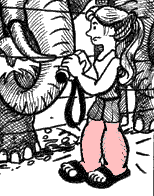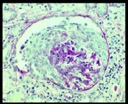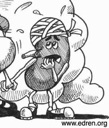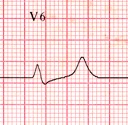Bare-bones case outlines aimed at late-stage medical students and others revising or preparing for nephrological experience.
Contents
1. Haematuria
 |
A patient presents with macroscopic painless haematuria, or microscopic haematuria is discovered incidentally at health screening. Links: Haematuria (Edren textbook); haematuria (EdRen INFO); management guidelines (EdRen GPinfo) for microscopic and macroscopic haematuria; Haematuria from the UK CKD eGuide (www.renal.org/ckd) |
2. Proteinuria
 |
Similar discovery of asymptomatic proteinuria, in various settings (eg entirely healthy patient, or patient with other evidence of renal disease).
Links: Proteinuria (EdRen textbook); proteinuria (EdRen INFO); proteinuria in renal disease (EdRen Handbook); management guidelines for proteinuria (EdRen GPinfo); Proteinuria from the UK CKD eGuide (www.renal.org/ckd) |
3. Oedema
 |
A patient presents with oedema, urine shows protein ++++, low JVP, low serum albumin. Aged young or old, and with or without associated disease.
Links: Oedema and nephrotic syndrome (EdRen textbook) nephrotic syndrome (EdRen INFO). Nephrotic syndrome (EdRen handbook). A 2-year old girl with oedema (Malawi cases) |
4. Acute renal inflammation
 |
A short illness with renal impairment, often hypertension, maybe with overt fluid retention, possibly with haematuria and proteinuria if caused by glomerulonephritis, less of this if caused by interstitial inflammation.
Links: Glomerulonephritis and interstitial nephritis (EdRen textbook). Homework: explain the reason for doing the tests to do in acute renal failure (the answers to some of these would imply advanced understanding). Glomerulonephritis and Interstitial nephritis (EdRen INFO). A 15 year old with oedema (and similar cases; Virtual Clinic) |
5. Acute renal failure (Acute kidney injury)
 |
Oliguria and rising serum creatinine and urea arising in the community or in hospital as part of an acute illness.
Links: ARF (AKI) (EdRen textbook). Management of ARF (EdRen handbook). ARF (AKI) for patients (EdRen INFO). AKI Cases – test yourself and learn with these (EdRen Resources) |
6. Chronic renal failure (probable)
 |
A patient presents with tiredness and is found to be hypertensive (175/110). There are minimal or no other features but they are found to be anaemic (Hb 100) and serum creatinine is 347 micromols/l (probable chronic renal failure).
Links: CKD 1-3 and CRF (CKD 4-5) (EdRen textbook); progression of chronic renal failure (EdRen INFO); blood pressure in renal disease (EdRen Handbook) |
7. Simple fluid and electrolyte disturbances
 |
Involving disordered volume status, potassium, sodium, calcium, and their emergency management or non-urgent management as appropriate.
Links: emergency management of hyperkalaemia (EdRen Handbook) |
8. UTI
 |
A patient with recurrent episodes of dysuria and urinary frequency associated with pyuria, with or without fever and loin pain.
Links: UTI (EdRen textbook); EdRen Resource page on UTI; UTI and cystitis (EdRen INFO) |
Our info sources are less comprehensive for these last four Mostly-Urology cases. Sorry about that.
